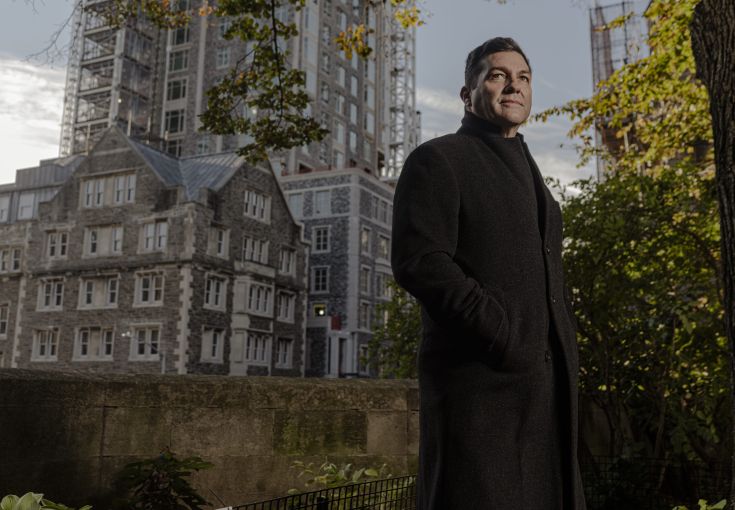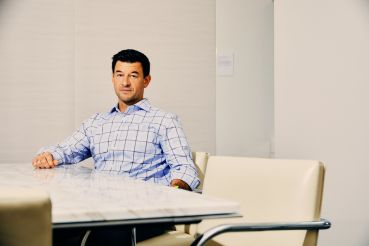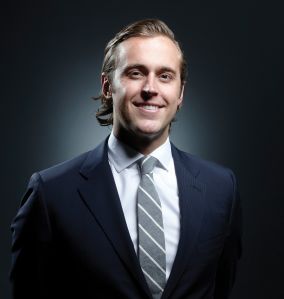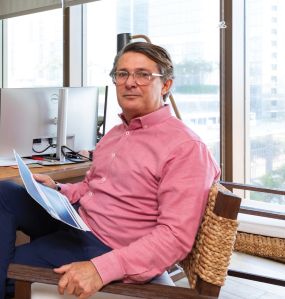Aussie Rules: Lendlease CEO Denis Hickey Talks ESG and 2022 Investment Goals
By Cathy Cunningham December 6, 2021 10:30 am
reprints
New York’s unique energy and dynamism is in part created by the passionate changemakers who travel across oceans and land to eventually call it home. One such changemaker is Denis Hickey, CEO and global COO of Lendlease.
Hickey arrived in New York almost 10 years ago from Australia to oversee all aspects of real estate development and investment management for the global behemoth, and lead Lendlease’s expansion in the U.S. Prior to taking the reins, he was CEO of ING Real Estate for Australia, and, further back, a professional cricketer.
As we head into 2022, Hickey is focused not only on the advancement of Lendlease’s activities post-pandemic, but on the firm’s commitment to leading the evolution of the real estate industry in being truly sustainable — environmentally, socially and economically. Changes don’t happen overnight, but Hickey isn’t backing down from the challenge — case in point, the firm has a bold target of absolute zero carbon emissions by 2040.
Commercial Observer chatted with Hickey in late October to learn more about the goals he’s setting, and what’s on his mind as we round out the year.
Commercial Observer: You’re Australian, but based in Lendlease’s New York office, is that correct?
Denis Hickey: That’s right. I’m originally from Melbourne, Australia, but moved to the U.S. in 2014.
How did you feel about such a big move at the time?
Well, prior to Lendlease I was CEO of ING Real Estate investment management in Australia. I had worked alongside Lendlease, but never in the company at that stage. Lendlease’s global CEO at the time convinced me of the global objectives of the group, and part of that objective growth was the U.S. market. So, I joined Lendlease with the intention of coming across here and trying to grow and restructure the U.S. platform, and the move to New York was always pretty exciting to me.
What are your thoughts on New York’s positioning in comparison with other cities recovering from COVID-19 today?
New York has definitely turned the corner and momentum is coming back to the city. In the dark days of the pandemic, there were a lot of eulogies written about New York City, but I never got that sense about it. I think that the same reasons people gravitated to living in big cities before the pandemic will remain the reasons after the pandemic, and we’re starting to see that now. People are moving back, and we’re seeing multifamily rents back at pre-COVID-19 numbers, so there’s high demand. The offices aren’t quite open yet, or not as much as they should be, but — as another example — Broadway is open. A friend of mine is in “Phantom of the Opera,” and performing to packed houses again.
I always say to people, “The reason you live in New York City is to actually be in the streets and to enjoy the restaurants, the activity, the entertainment, the sport, the connection.” So when the pandemic hit, when all of that shut down, the drive to live in New York went away, understandably. But now, the momentum is turning again.
Lendlease stayed busy throughout the pandemic in New York City, with new projects including 100 Claremont. Where does that project stand today?
The pandemic was underway when we pushed the button on 100 Claremont’s construction, and we actually just topped out on the building in October. It’s 41 stories in a super location adjacent to the Columbia University campus, and we think that part of the Upper West Side is an untapped gem. The unique aspect is its location at the Union Theological Seminary. Being a part of that complex — and we’ve developed a very sympathetic building that fits the historic nature of the UTS site — really gives it a uniqueness, and therefore it feels part of a compound and the whole historic area.
You also acquired the 2.6-acre 1 Java Street on the Brooklyn waterfront with plans to develop an 800-unit apartment building there. Why was this a good fit for Lendlease?
We like the Brooklyn waterfront because there’s a deep history of regeneration there, and there’s uniqueness in the culture and the diverse communities that live on that waterfront. So, we like that part of the world, and we had been looking at that site for a while. It was originally touted before the pandemic, but when the pandemic hit there was an opportunity for us to take a minority stake from the existing owners, and we think we bought it well. We were able to move fast — which enabled us to secure the site — and it’s a whole waterfront block, which gives us a lot of scale to do something different.
You’re developing the project with rising sea levels in mind and have a big focus on Environmental, Social and Governance, or ESG, as a company, more broadly speaking. Can you talk me through your approach to sustainability?
Lendlease has a deep, long history in sustainability and being mindful of our contribution to the environment. A lot of people greenwash [when a company tries to present itself as more environmentally minded than it actually is] some of these things, but our involvement in the sustainability agenda spans 50 years. Our founder was very mindful of the need for corporations to be giving back to communities and giving back from a social agenda and an economic perspective. So this approach runs deep through Lendlease, and we have a real sense of legacy about what we create. So, anything to do with the environment or social contribution is really important to us.
When it comes to rising sea levels, that’s a no-brainer, as New York has experienced this scenario before with Hurricane Sandy. But, there are some really interesting ways you can address this. In Clippership Wharf, our project in Boston, we did an active waterfront and that was really pioneering and won lots of awards. So, there are lots of things you can do that don’t cost an enormous amount of money but future-proof these buildings and create a very open solution for the community.
Lendlease also has a goal of being absolute zero carbon across the board by 2040.
Yes, we were pretty bold in our absolute zero program, and there are three scopes to it. Scope one is around the fuels that we burn as an organization, scope two is about the energy that we use, and scope three is about the upstream and downstream impact that we as a company have on the supply chain. So we came out and said we’re going to be net zero by 2025 on scopes, which means that if we haven’t got to net zero by 2025, then we will look at offsets.
The offsets we’re using are not just paying a fee, they’re trying to find a way that we can actually contribute to the generation of energy solutions. So, we’re very excited about that but it’s a big challenge. And then being absolute zero across all of the real estate spectrum by 2040, again, is a big challenge but we’re fully committed. We’ve been doing a lot with our supply chain, thinking about how energy is consumed in the fabrication of materials and the concrete, steel, what labor is used, etcetera. So, it’s a massive commitment from the company.
What’s your take on how successfully we, as an industry, are moving toward a more sustainable existence?
The whole sustainability thing has been an interesting, interesting evolution. It started out as more of a compliance objective, then you saw some companies take a leadership position in trying to push the boundaries on [energy] star ratings, or energy solutions, or water and so forth. Then, the next iteration you saw is consumers demanding that sustainable product in their buildings. So, in the last 10 to 15 years, you’ve seen a rise in consumers demanding these outcomes, which therefore means real estate companies need to provide that solution.
The next wave is capital. You’re now seeing capital being held accountable for its role in the production of real estate and management of real estate. Whether they’re investment managers, banks, funds, you’re really seeing an awareness around their contribution to society and the environment.
It really takes a village, in terms of all the different stakeholders pulling together to effect change.
It’s an interesting one. When the Trump government came in, there was a rollback in the U.S.’ commitment to the environment, but you saw corporate America step up and fill that void. And we were one of those companies who said, “Well, we’re going to move in the opposite direction of rolling back those initiatives, and we’re going to put ourselves forward and put out ambitious targets and be a part of the solution for the bigger, wider sustainability agenda.”
Younger generations really seem to be leading the charge saying, “This is our planet. Do better.” Do you find that too?
You’re exactly right. I’ve got four kids, and they’re all in their teens or their early 20s. And I can tell you from the perspective of that market sample, in my house, that they’re very committed. They give me a hard time every now and again, asking, “What are you doing? How are you recycling? What is your vision?” Their friends are all very similar, and I think that’s an outstanding thing. And these kids are now choosing which company they want to work for. They don’t want to work for a company that doesn’t believe in a need to contribute to the environment around it, whether it’s around diversity, inclusion or sustainability.
I think corporations need to be more accountable to society as a whole, and I think the young kids are demanding that, whether it’s in consumerism, or whether it’s in their work choices, or whether it’s in their accommodation choices. It’s a much bigger driving factor than ever before.
How is Lendlease approaching Diversity, Equity and Inclusion today?
Lendlease has, for the past 15 years, been very focused on creating equality in the workforce as a whole. In Australia, we’ve been very focused on indigenous equality. In the U.S., we’ve had a multicultural focus, but the events of May 2020 with George Floyd really made America as a whole say, “It’s time to stand up and be more active than we have been.” And Lendease was a part of that.
From my perspective, being a foreigner, I was probably not fully aware of the extent of the systemic [racism] here. I’d read about it from offshore, but I hadn’t felt the undercurrent. There was a moment for me when I moved here when I went with my wife to Memphis and we went to the National Civil Rights Museum there, which is at Martin Luther King’s assassination site. I spent hours there and it was a really moving depiction of the history of Black oppression and slavery and racism that existed throughout America, that was a really telling moment for me. I walked away and thought, “Wow, I need to learn more about this.” So I tried to educate myself. Then, when the George Floyd murder happened, that was really a big moment of, “Okay, I need to step up to the plate and I need to be accountable.”
How can we as an industry best hold ourselves accountable?
I think signing up to groups and forums where we share best practices helps, because everybody likes to reinvent the wheel but we don’t always need to — there is a lot of great learning from lots of people out there. If you can connect with people who share similar objectives, you can discuss their initiatives. I think the more forums that share experiences and share objectives is really important.
I think the other thing is visibility of data. What we found with gender equality was there was a reluctance for people to share data because it was an embarrassment factor. We, as a house, participate in a program in Australia called Male Champions of Change, which is all about males in the broader workforce being the leaders and champions of gender diversity. And part of that was us disclosing our data to hold ourselves accountable. We need to adopt the same approach to racial diversity, and we need to be transparent with our data and open and honest. It takes time to move, so everyone will want the numbers to change tomorrow but that doesn’t happen. The first step is really being a bit vulnerable and being open about where we are on that journey.
We have a diversity, equity and inclusion advisory council at Lendlease, which is a cross representation of the company that meets every couple of months. We have external people who also sit on that advisory council who can bring a different perspective to the table and hold that lens up to us and say, “You’re doing better or worse than your peers.” What we’ve learned is that just talking and saying things is nice, but you need to put in a structure and a framework to enact change, and it needs to be embedded. We’re well on the path of putting that framework in, and, ultimately, that will enable us to drive the change.
Switching gears back to deal flow, Lendlease has been making big strides in L.A. and Chicago. How are you looking at markets now in terms of opportunity?
It’s interesting, because mainland America is the same size as mainland Australia. And one has 350 million people and one has 25 million [laughs]. So, if you fly from the east to the west in Australia, you look out the window and you don’t see anything. When I first came to America, I was really figuring out where we wanted to play, because there’s a lot of opportunity in this country, and you can’t play in every market. We want to focus on the big gateway cities, and that’s really Boston, New York, San Francisco, Los Angeles and the Bay Area. We believe that they’re deep, they’re robust, and they’re diverse economies with strong population growth.
We’ve seen investors targeting secondary markets more during COVID. Is that something you can see Lendlease doing in the future?
It’s a great question. I think there are two different opportunities there. First of all, we’re always assessing secondary markets, whether they’re in Seattle or in Austin, or Denver, but I do think there’s a difference between being a developer or an asset owner in these markets. When you’re buying an existing asset, you can move in and out of markets more quickly than you can when you’re an active generator of product. If we look at our investment portfolio for an asset, we can say, “Okay, we think X city is great for the next two or three years, because you can drive performance out of this office asset in X city.” So, you might want to be a holder of assets for two or three years, but you move in and out of those cities quickly.
On the development or construction side, it’s harder to move in and out of those cities quickly. So, at this stage, we focus on development and construction activity in gateway cities, and, if we’re looking at investment activities, we’d be more fluid in secondary markets.
How did you first get interested in real estate?
I kind of fell into it. I did a commerce degree at university many years ago and I got introduced to Jennings Group in Australia. The person who was running the South Australian market — I was living in South Australia at the time — said: “You seem to have half a brain so why don’t you come in and we’ll teach you the real estate sector?” I didn’t know anything about it at the time, but I’ve been in it for a number of years now.
What has kept you in the industry?
I think the thing about real estate is it’s truly dynamic. The complexity from an investment perspective or real estate investment and the structuring aspect and how you can drive outperformance is really fascinating. Then, the development and construction side of real estate is also fascinating because it’s project-based, and every project is new. So, that continual reinvention of your thought process is really attractive to me. And, on the investment side, there’s the intrigue around how you use capital to drive returns and how you think about driving performance.
What are your hobbies outside of work?
Well, I’ve just become an empty nester, which is really nice [laughs]. My youngest just went to the University of Arizona, which means my wife and I are home looking at each other saying, “What do we do now?” I also really like to travel. I like seeing the world and there’s so much to see across America. I also love golf. I don’t play enough of it, and I hope to play more now that I’m in this next phase.


